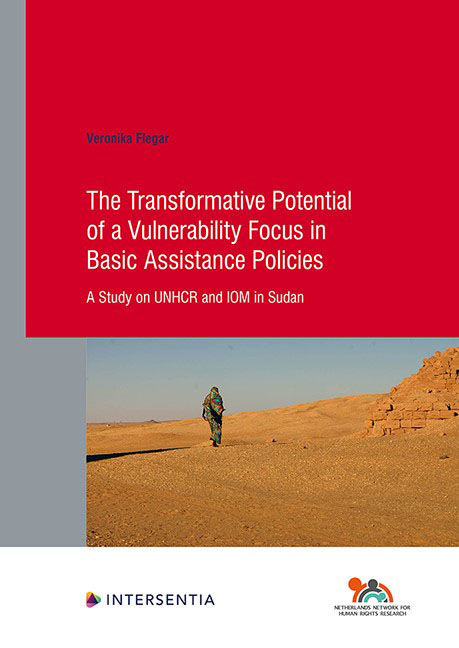 The Transformative Potential of a Vulnerability Focus in Basic Assistance Policies
The Transformative Potential of a Vulnerability Focus in Basic Assistance Policies Published online by Cambridge University Press: 11 November 2021
This study investigates the transformative potential of a vulnerability focus in basic assistance policies. It includes two case studies on such policies, both set in Khartoum, Sudan. The first case study focuses on the United Nations High Commissioner for Refugees (UNHCR) while the second case study centres on the International Organisation for Migration (IOM). The analysis concentrates on basic assistance providers, i.e. on the case workers and their direct superiors who design and implement the respective basic assistance policies.
This opening chapter outlines the research topic and approach of this study. It starts with an overview of the relevance and focus of this research (1.1 – 1.3). Subsequently, the chapter explains the study's embeddedness in the sociology of human rights (1.4) and its epistemological standpoint of critical pragmatism (1.5). The chapter then proceeds to present the research approach (1.6) and ends with a section on key terminology choices (1.7) and an overview of the structure of the book (1.8).
THE INCREASED FOCUS ON, BUT DISPUTABLE VALUE OF, VULNERABILITY
‘Vulnerability’ seems to have become a buzz-word in law and policy and some even speak of “[a] vulnerability zeitgeist”. The term serves as a tool for understanding and addressing social problems and “now stretches into so many governance areas it is difficult to keep track, permeating policy matters ranging from violence against women to volcanoes”. Despite – or perhaps because of – this multifaceted use, vulnerability is not a clear-cut or neutral concept. Rather, the notion of vulnerability brings with it a variety of different connotations and dilemmas that often remain obscured. This obscurity around the notion's content, choices and context raises the question whether and to what extent the increased attention to vulnerability is desirable from a human rights perspective: does a vulnerability focus ensure or endanger the realisation of universal human rights? Previous authors appear to be somewhat divided on this issue.
Proponents of increased attention to vulnerability are generally inclined to view the notion as beneficial for the realisation of universal human rights. They argue that, by focusing on humans as embodied and socially embedded, the vulnerability notion emphasises the ‘human’, rather than the ‘rights’, element of the human rights paradigm.
To save this book to your Kindle, first ensure [email protected] is added to your Approved Personal Document E-mail List under your Personal Document Settings on the Manage Your Content and Devices page of your Amazon account. Then enter the ‘name’ part of your Kindle email address below. Find out more about saving to your Kindle.
Note you can select to save to either the @free.kindle.com or @kindle.com variations. ‘@free.kindle.com’ emails are free but can only be saved to your device when it is connected to wi-fi. ‘@kindle.com’ emails can be delivered even when you are not connected to wi-fi, but note that service fees apply.
Find out more about the Kindle Personal Document Service.
To save content items to your account, please confirm that you agree to abide by our usage policies. If this is the first time you use this feature, you will be asked to authorise Cambridge Core to connect with your account. Find out more about saving content to Dropbox.
To save content items to your account, please confirm that you agree to abide by our usage policies. If this is the first time you use this feature, you will be asked to authorise Cambridge Core to connect with your account. Find out more about saving content to Google Drive.